HRD Practices and Organizational Effectiveness in Jordan's Education
VerifiedAdded on 2020/04/15
|38
|10476
|342
Report
AI Summary
This report examines the effect of Human Resource Development (HRD) practices on the Ministry of Education in Jordan. It explores the importance of HRD in enhancing employee skills, organizational effectiveness, and addressing challenges within the education sector. The study employs both primary and secondary data analysis, including interviews with managerial heads, to assess the impact of HRD practices like training. The report highlights the significance of HRD in improving staff performance, curriculum development, and overall educational system management. It discusses the current state of the Jordanian educational system, the need for HRD to meet the evolving needs of the sector, and provides insights into how HRD can contribute to the development of the education ministry's policies and infrastructure.
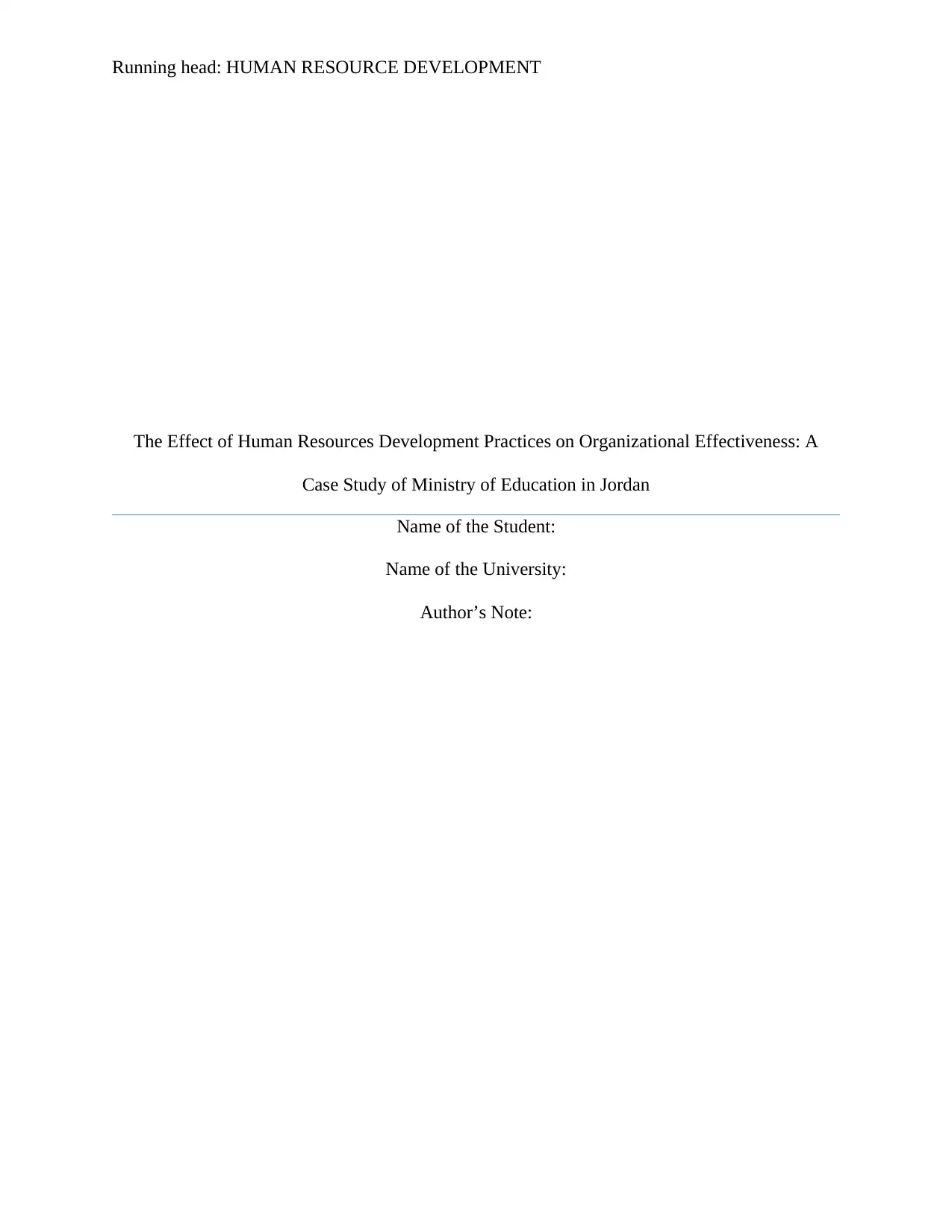
Running head: HUMAN RESOURCE DEVELOPMENT
The Effect of Human Resources Development Practices on Organizational Effectiveness: A
Case Study of Ministry of Education in Jordan
Name of the Student:
Name of the University:
Author’s Note:
The Effect of Human Resources Development Practices on Organizational Effectiveness: A
Case Study of Ministry of Education in Jordan
Name of the Student:
Name of the University:
Author’s Note:
Paraphrase This Document
Need a fresh take? Get an instant paraphrase of this document with our AI Paraphraser
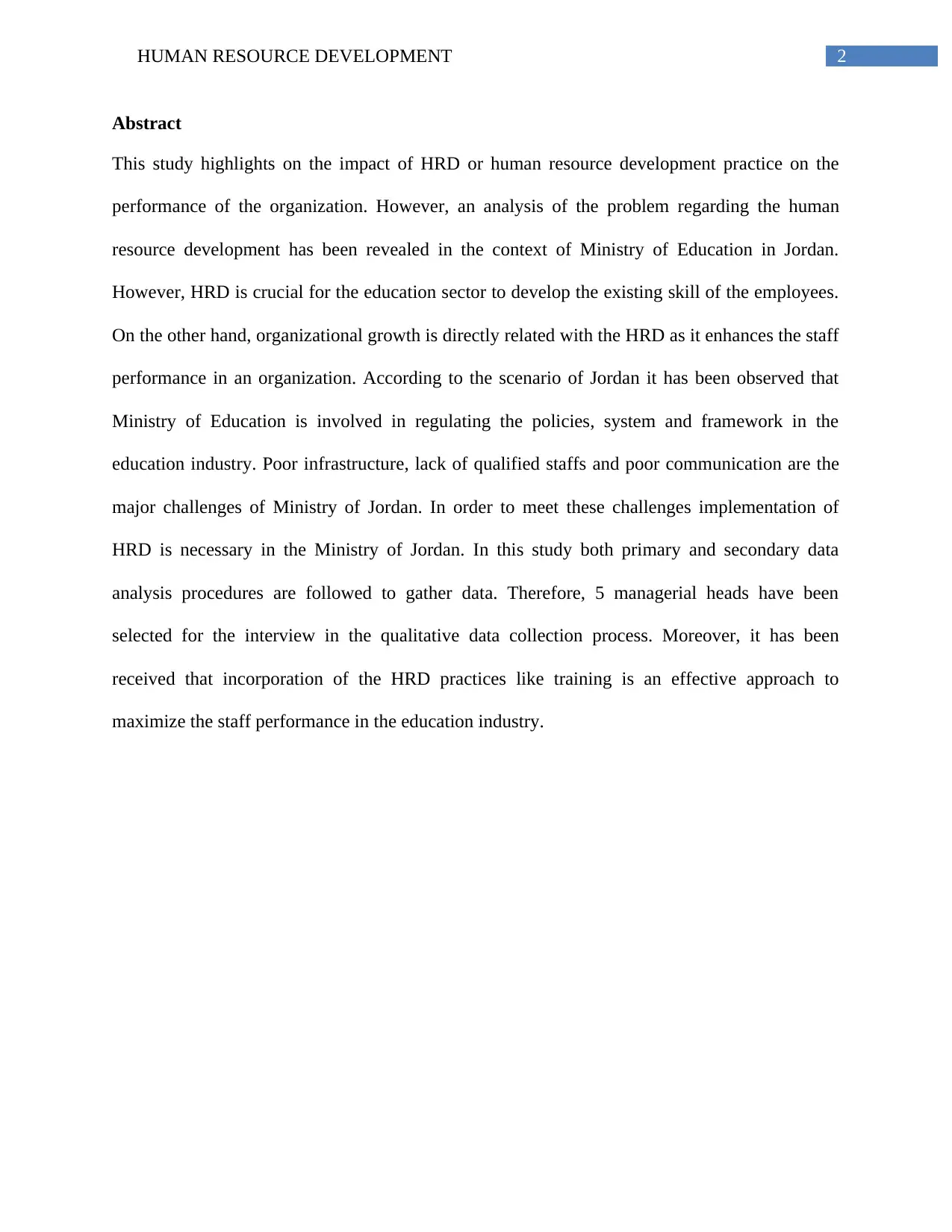
2HUMAN RESOURCE DEVELOPMENT
Abstract
This study highlights on the impact of HRD or human resource development practice on the
performance of the organization. However, an analysis of the problem regarding the human
resource development has been revealed in the context of Ministry of Education in Jordan.
However, HRD is crucial for the education sector to develop the existing skill of the employees.
On the other hand, organizational growth is directly related with the HRD as it enhances the staff
performance in an organization. According to the scenario of Jordan it has been observed that
Ministry of Education is involved in regulating the policies, system and framework in the
education industry. Poor infrastructure, lack of qualified staffs and poor communication are the
major challenges of Ministry of Jordan. In order to meet these challenges implementation of
HRD is necessary in the Ministry of Jordan. In this study both primary and secondary data
analysis procedures are followed to gather data. Therefore, 5 managerial heads have been
selected for the interview in the qualitative data collection process. Moreover, it has been
received that incorporation of the HRD practices like training is an effective approach to
maximize the staff performance in the education industry.
Abstract
This study highlights on the impact of HRD or human resource development practice on the
performance of the organization. However, an analysis of the problem regarding the human
resource development has been revealed in the context of Ministry of Education in Jordan.
However, HRD is crucial for the education sector to develop the existing skill of the employees.
On the other hand, organizational growth is directly related with the HRD as it enhances the staff
performance in an organization. According to the scenario of Jordan it has been observed that
Ministry of Education is involved in regulating the policies, system and framework in the
education industry. Poor infrastructure, lack of qualified staffs and poor communication are the
major challenges of Ministry of Jordan. In order to meet these challenges implementation of
HRD is necessary in the Ministry of Jordan. In this study both primary and secondary data
analysis procedures are followed to gather data. Therefore, 5 managerial heads have been
selected for the interview in the qualitative data collection process. Moreover, it has been
received that incorporation of the HRD practices like training is an effective approach to
maximize the staff performance in the education industry.
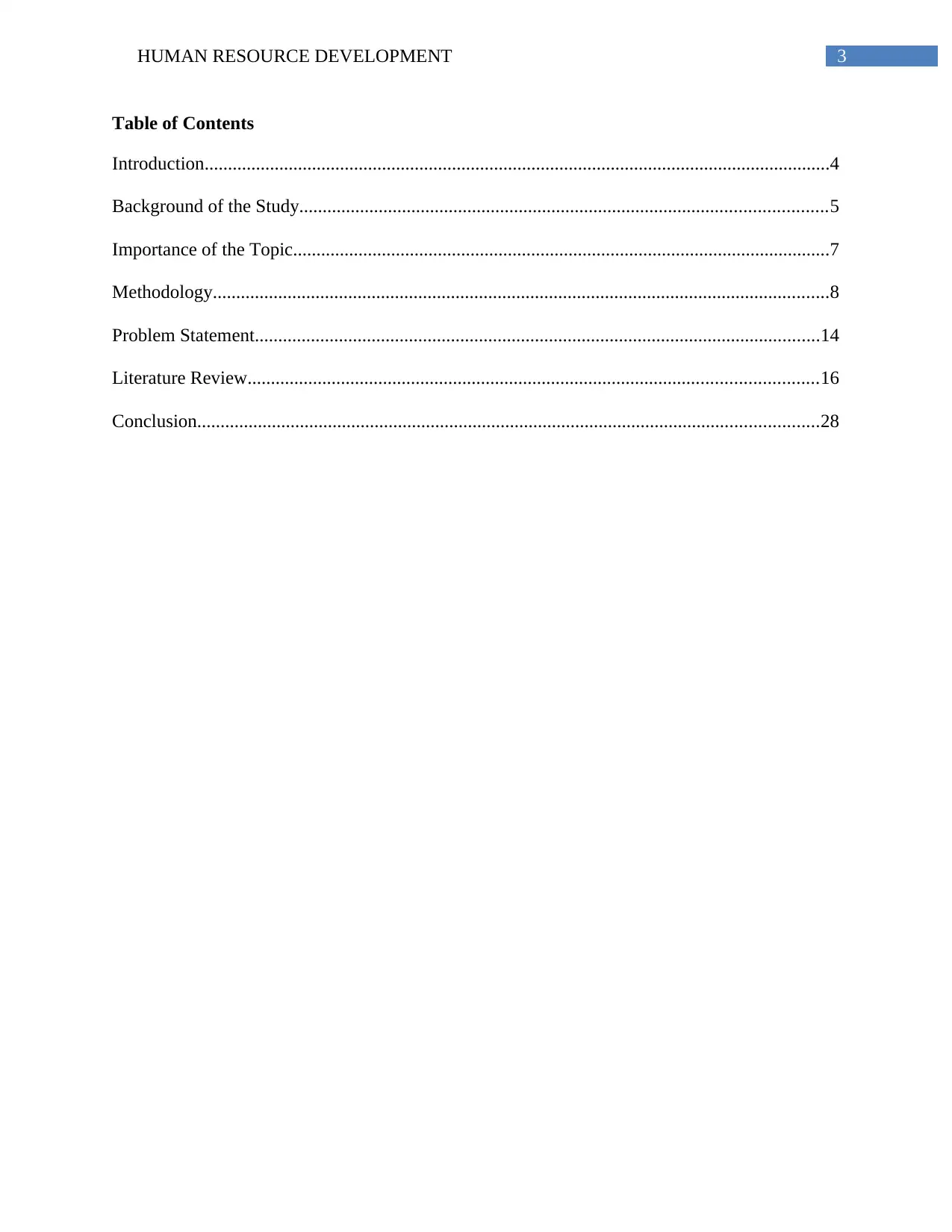
3HUMAN RESOURCE DEVELOPMENT
Table of Contents
Introduction......................................................................................................................................4
Background of the Study.................................................................................................................5
Importance of the Topic...................................................................................................................7
Methodology....................................................................................................................................8
Problem Statement.........................................................................................................................14
Literature Review..........................................................................................................................16
Conclusion.....................................................................................................................................28
Table of Contents
Introduction......................................................................................................................................4
Background of the Study.................................................................................................................5
Importance of the Topic...................................................................................................................7
Methodology....................................................................................................................................8
Problem Statement.........................................................................................................................14
Literature Review..........................................................................................................................16
Conclusion.....................................................................................................................................28
⊘ This is a preview!⊘
Do you want full access?
Subscribe today to unlock all pages.

Trusted by 1+ million students worldwide
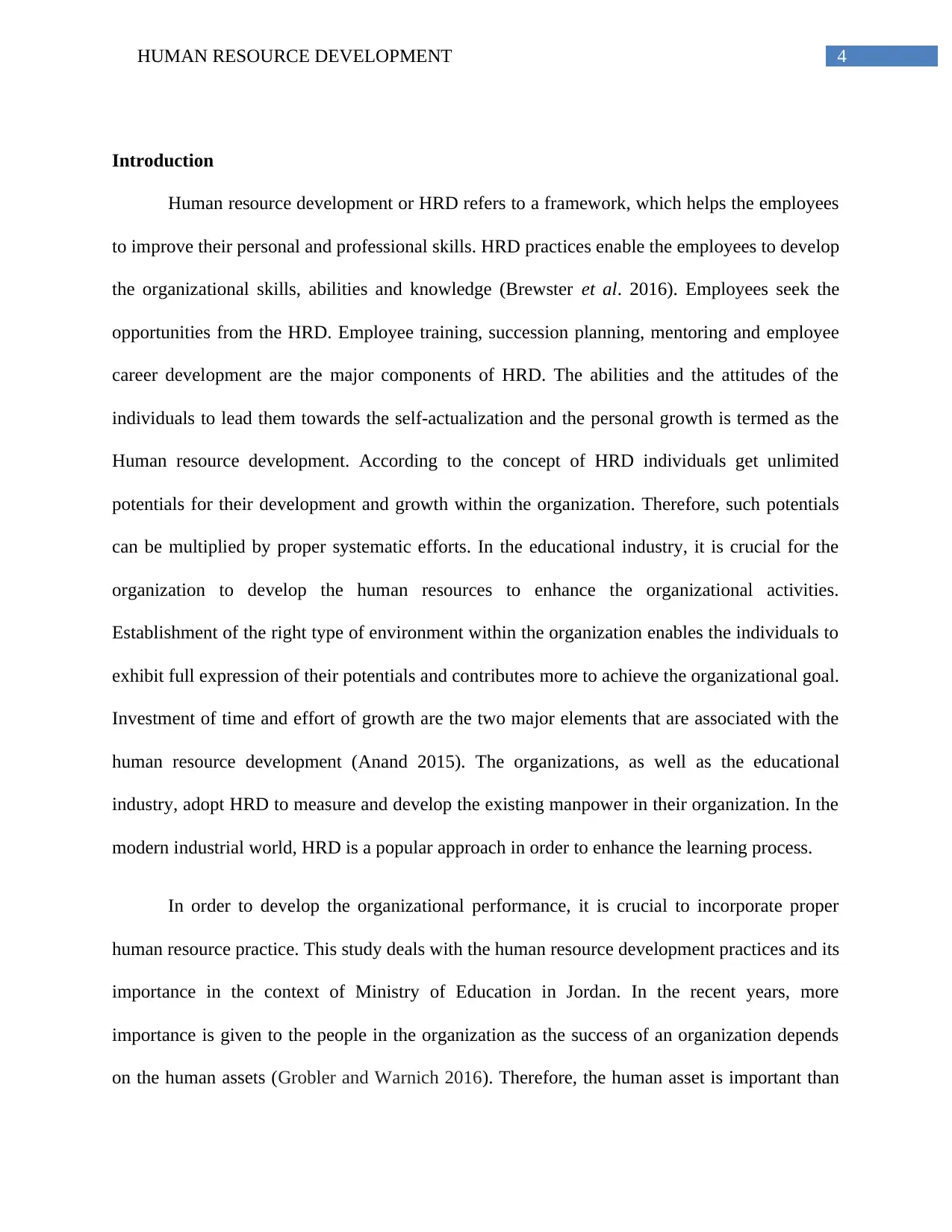
4HUMAN RESOURCE DEVELOPMENT
Introduction
Human resource development or HRD refers to a framework, which helps the employees
to improve their personal and professional skills. HRD practices enable the employees to develop
the organizational skills, abilities and knowledge (Brewster et al. 2016). Employees seek the
opportunities from the HRD. Employee training, succession planning, mentoring and employee
career development are the major components of HRD. The abilities and the attitudes of the
individuals to lead them towards the self-actualization and the personal growth is termed as the
Human resource development. According to the concept of HRD individuals get unlimited
potentials for their development and growth within the organization. Therefore, such potentials
can be multiplied by proper systematic efforts. In the educational industry, it is crucial for the
organization to develop the human resources to enhance the organizational activities.
Establishment of the right type of environment within the organization enables the individuals to
exhibit full expression of their potentials and contributes more to achieve the organizational goal.
Investment of time and effort of growth are the two major elements that are associated with the
human resource development (Anand 2015). The organizations, as well as the educational
industry, adopt HRD to measure and develop the existing manpower in their organization. In the
modern industrial world, HRD is a popular approach in order to enhance the learning process.
In order to develop the organizational performance, it is crucial to incorporate proper
human resource practice. This study deals with the human resource development practices and its
importance in the context of Ministry of Education in Jordan. In the recent years, more
importance is given to the people in the organization as the success of an organization depends
on the human assets (Grobler and Warnich 2016). Therefore, the human asset is important than
Introduction
Human resource development or HRD refers to a framework, which helps the employees
to improve their personal and professional skills. HRD practices enable the employees to develop
the organizational skills, abilities and knowledge (Brewster et al. 2016). Employees seek the
opportunities from the HRD. Employee training, succession planning, mentoring and employee
career development are the major components of HRD. The abilities and the attitudes of the
individuals to lead them towards the self-actualization and the personal growth is termed as the
Human resource development. According to the concept of HRD individuals get unlimited
potentials for their development and growth within the organization. Therefore, such potentials
can be multiplied by proper systematic efforts. In the educational industry, it is crucial for the
organization to develop the human resources to enhance the organizational activities.
Establishment of the right type of environment within the organization enables the individuals to
exhibit full expression of their potentials and contributes more to achieve the organizational goal.
Investment of time and effort of growth are the two major elements that are associated with the
human resource development (Anand 2015). The organizations, as well as the educational
industry, adopt HRD to measure and develop the existing manpower in their organization. In the
modern industrial world, HRD is a popular approach in order to enhance the learning process.
In order to develop the organizational performance, it is crucial to incorporate proper
human resource practice. This study deals with the human resource development practices and its
importance in the context of Ministry of Education in Jordan. In the recent years, more
importance is given to the people in the organization as the success of an organization depends
on the human assets (Grobler and Warnich 2016). Therefore, the human asset is important than
Paraphrase This Document
Need a fresh take? Get an instant paraphrase of this document with our AI Paraphraser
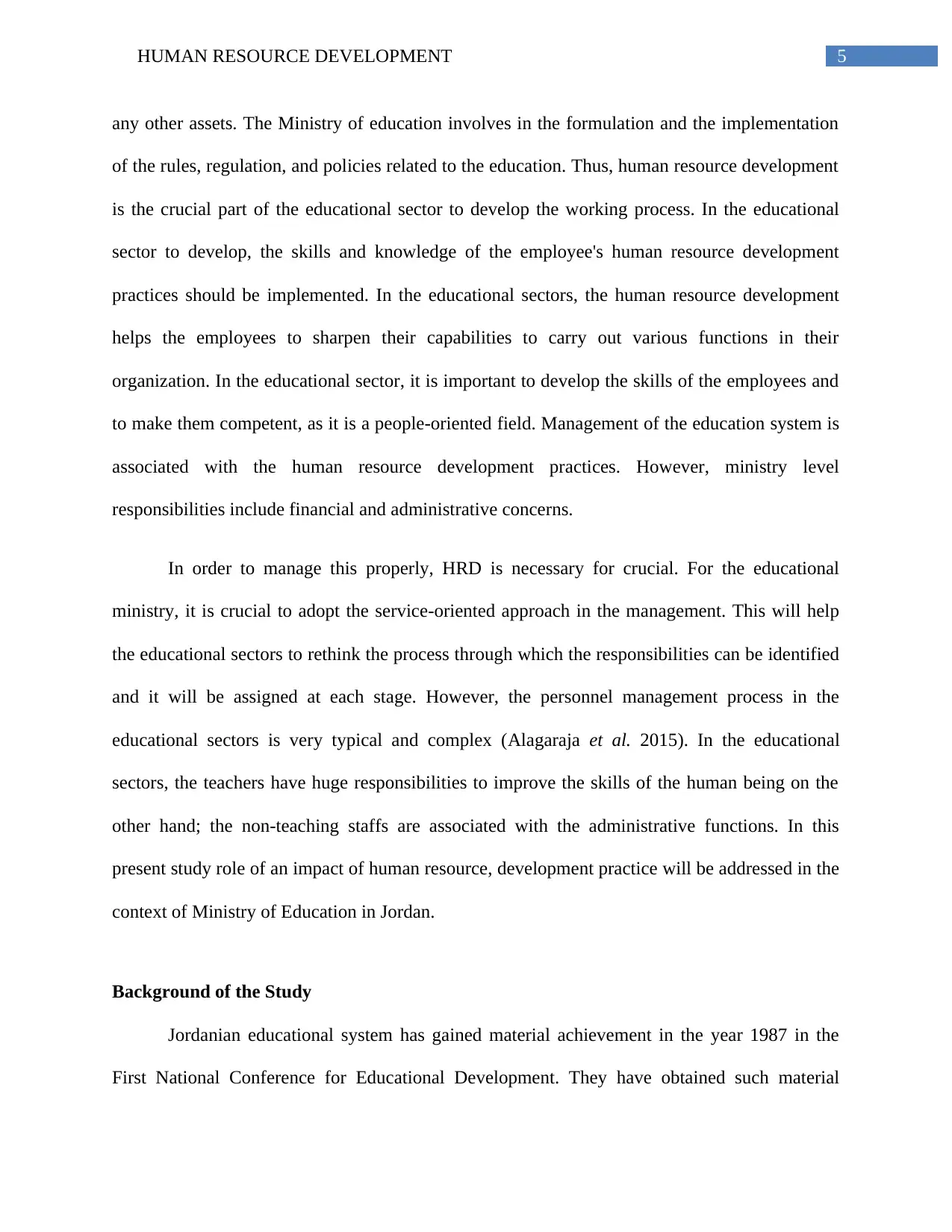
5HUMAN RESOURCE DEVELOPMENT
any other assets. The Ministry of education involves in the formulation and the implementation
of the rules, regulation, and policies related to the education. Thus, human resource development
is the crucial part of the educational sector to develop the working process. In the educational
sector to develop, the skills and knowledge of the employee's human resource development
practices should be implemented. In the educational sectors, the human resource development
helps the employees to sharpen their capabilities to carry out various functions in their
organization. In the educational sector, it is important to develop the skills of the employees and
to make them competent, as it is a people-oriented field. Management of the education system is
associated with the human resource development practices. However, ministry level
responsibilities include financial and administrative concerns.
In order to manage this properly, HRD is necessary for crucial. For the educational
ministry, it is crucial to adopt the service-oriented approach in the management. This will help
the educational sectors to rethink the process through which the responsibilities can be identified
and it will be assigned at each stage. However, the personnel management process in the
educational sectors is very typical and complex (Alagaraja et al. 2015). In the educational
sectors, the teachers have huge responsibilities to improve the skills of the human being on the
other hand; the non-teaching staffs are associated with the administrative functions. In this
present study role of an impact of human resource, development practice will be addressed in the
context of Ministry of Education in Jordan.
Background of the Study
Jordanian educational system has gained material achievement in the year 1987 in the
First National Conference for Educational Development. They have obtained such material
any other assets. The Ministry of education involves in the formulation and the implementation
of the rules, regulation, and policies related to the education. Thus, human resource development
is the crucial part of the educational sector to develop the working process. In the educational
sector to develop, the skills and knowledge of the employee's human resource development
practices should be implemented. In the educational sectors, the human resource development
helps the employees to sharpen their capabilities to carry out various functions in their
organization. In the educational sector, it is important to develop the skills of the employees and
to make them competent, as it is a people-oriented field. Management of the education system is
associated with the human resource development practices. However, ministry level
responsibilities include financial and administrative concerns.
In order to manage this properly, HRD is necessary for crucial. For the educational
ministry, it is crucial to adopt the service-oriented approach in the management. This will help
the educational sectors to rethink the process through which the responsibilities can be identified
and it will be assigned at each stage. However, the personnel management process in the
educational sectors is very typical and complex (Alagaraja et al. 2015). In the educational
sectors, the teachers have huge responsibilities to improve the skills of the human being on the
other hand; the non-teaching staffs are associated with the administrative functions. In this
present study role of an impact of human resource, development practice will be addressed in the
context of Ministry of Education in Jordan.
Background of the Study
Jordanian educational system has gained material achievement in the year 1987 in the
First National Conference for Educational Development. They have obtained such material
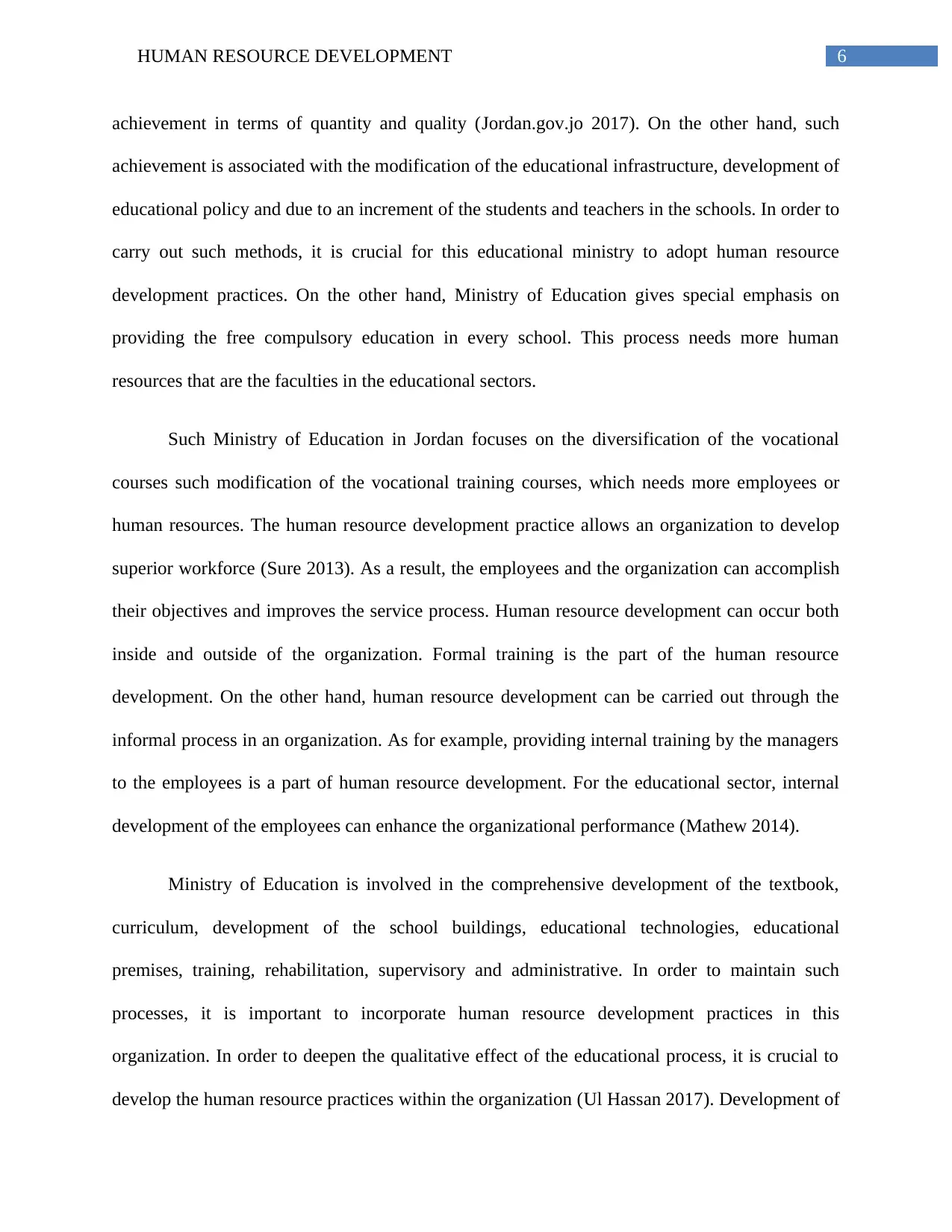
6HUMAN RESOURCE DEVELOPMENT
achievement in terms of quantity and quality (Jordan.gov.jo 2017). On the other hand, such
achievement is associated with the modification of the educational infrastructure, development of
educational policy and due to an increment of the students and teachers in the schools. In order to
carry out such methods, it is crucial for this educational ministry to adopt human resource
development practices. On the other hand, Ministry of Education gives special emphasis on
providing the free compulsory education in every school. This process needs more human
resources that are the faculties in the educational sectors.
Such Ministry of Education in Jordan focuses on the diversification of the vocational
courses such modification of the vocational training courses, which needs more employees or
human resources. The human resource development practice allows an organization to develop
superior workforce (Sure 2013). As a result, the employees and the organization can accomplish
their objectives and improves the service process. Human resource development can occur both
inside and outside of the organization. Formal training is the part of the human resource
development. On the other hand, human resource development can be carried out through the
informal process in an organization. As for example, providing internal training by the managers
to the employees is a part of human resource development. For the educational sector, internal
development of the employees can enhance the organizational performance (Mathew 2014).
Ministry of Education is involved in the comprehensive development of the textbook,
curriculum, development of the school buildings, educational technologies, educational
premises, training, rehabilitation, supervisory and administrative. In order to maintain such
processes, it is important to incorporate human resource development practices in this
organization. In order to deepen the qualitative effect of the educational process, it is crucial to
develop the human resource practices within the organization (Ul Hassan 2017). Development of
achievement in terms of quantity and quality (Jordan.gov.jo 2017). On the other hand, such
achievement is associated with the modification of the educational infrastructure, development of
educational policy and due to an increment of the students and teachers in the schools. In order to
carry out such methods, it is crucial for this educational ministry to adopt human resource
development practices. On the other hand, Ministry of Education gives special emphasis on
providing the free compulsory education in every school. This process needs more human
resources that are the faculties in the educational sectors.
Such Ministry of Education in Jordan focuses on the diversification of the vocational
courses such modification of the vocational training courses, which needs more employees or
human resources. The human resource development practice allows an organization to develop
superior workforce (Sure 2013). As a result, the employees and the organization can accomplish
their objectives and improves the service process. Human resource development can occur both
inside and outside of the organization. Formal training is the part of the human resource
development. On the other hand, human resource development can be carried out through the
informal process in an organization. As for example, providing internal training by the managers
to the employees is a part of human resource development. For the educational sector, internal
development of the employees can enhance the organizational performance (Mathew 2014).
Ministry of Education is involved in the comprehensive development of the textbook,
curriculum, development of the school buildings, educational technologies, educational
premises, training, rehabilitation, supervisory and administrative. In order to maintain such
processes, it is important to incorporate human resource development practices in this
organization. In order to deepen the qualitative effect of the educational process, it is crucial to
develop the human resource practices within the organization (Ul Hassan 2017). Development of
⊘ This is a preview!⊘
Do you want full access?
Subscribe today to unlock all pages.

Trusted by 1+ million students worldwide
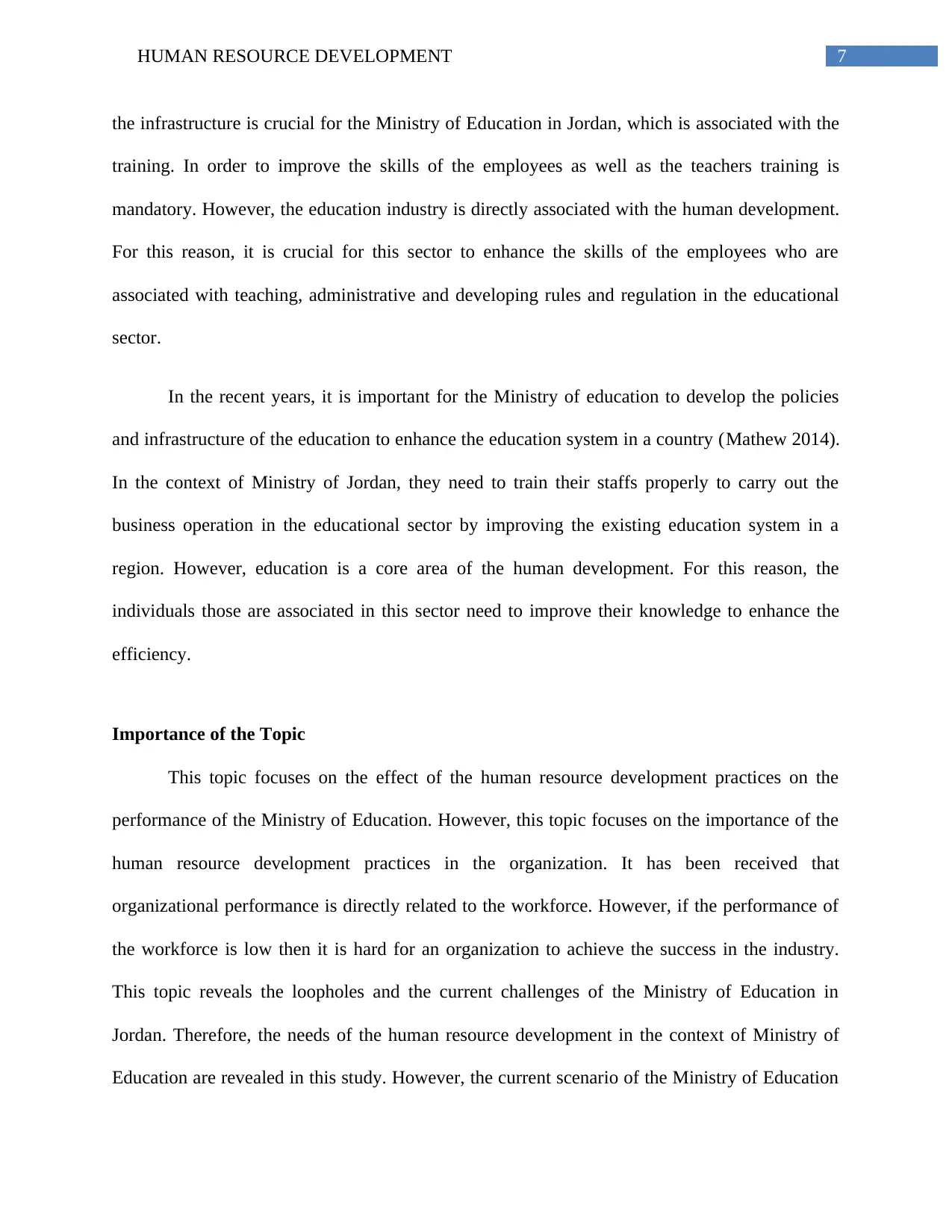
7HUMAN RESOURCE DEVELOPMENT
the infrastructure is crucial for the Ministry of Education in Jordan, which is associated with the
training. In order to improve the skills of the employees as well as the teachers training is
mandatory. However, the education industry is directly associated with the human development.
For this reason, it is crucial for this sector to enhance the skills of the employees who are
associated with teaching, administrative and developing rules and regulation in the educational
sector.
In the recent years, it is important for the Ministry of education to develop the policies
and infrastructure of the education to enhance the education system in a country (Mathew 2014).
In the context of Ministry of Jordan, they need to train their staffs properly to carry out the
business operation in the educational sector by improving the existing education system in a
region. However, education is a core area of the human development. For this reason, the
individuals those are associated in this sector need to improve their knowledge to enhance the
efficiency.
Importance of the Topic
This topic focuses on the effect of the human resource development practices on the
performance of the Ministry of Education. However, this topic focuses on the importance of the
human resource development practices in the organization. It has been received that
organizational performance is directly related to the workforce. However, if the performance of
the workforce is low then it is hard for an organization to achieve the success in the industry.
This topic reveals the loopholes and the current challenges of the Ministry of Education in
Jordan. Therefore, the needs of the human resource development in the context of Ministry of
Education are revealed in this study. However, the current scenario of the Ministry of Education
the infrastructure is crucial for the Ministry of Education in Jordan, which is associated with the
training. In order to improve the skills of the employees as well as the teachers training is
mandatory. However, the education industry is directly associated with the human development.
For this reason, it is crucial for this sector to enhance the skills of the employees who are
associated with teaching, administrative and developing rules and regulation in the educational
sector.
In the recent years, it is important for the Ministry of education to develop the policies
and infrastructure of the education to enhance the education system in a country (Mathew 2014).
In the context of Ministry of Jordan, they need to train their staffs properly to carry out the
business operation in the educational sector by improving the existing education system in a
region. However, education is a core area of the human development. For this reason, the
individuals those are associated in this sector need to improve their knowledge to enhance the
efficiency.
Importance of the Topic
This topic focuses on the effect of the human resource development practices on the
performance of the Ministry of Education. However, this topic focuses on the importance of the
human resource development practices in the organization. It has been received that
organizational performance is directly related to the workforce. However, if the performance of
the workforce is low then it is hard for an organization to achieve the success in the industry.
This topic reveals the loopholes and the current challenges of the Ministry of Education in
Jordan. Therefore, the needs of the human resource development in the context of Ministry of
Education are revealed in this study. However, the current scenario of the Ministry of Education
Paraphrase This Document
Need a fresh take? Get an instant paraphrase of this document with our AI Paraphraser
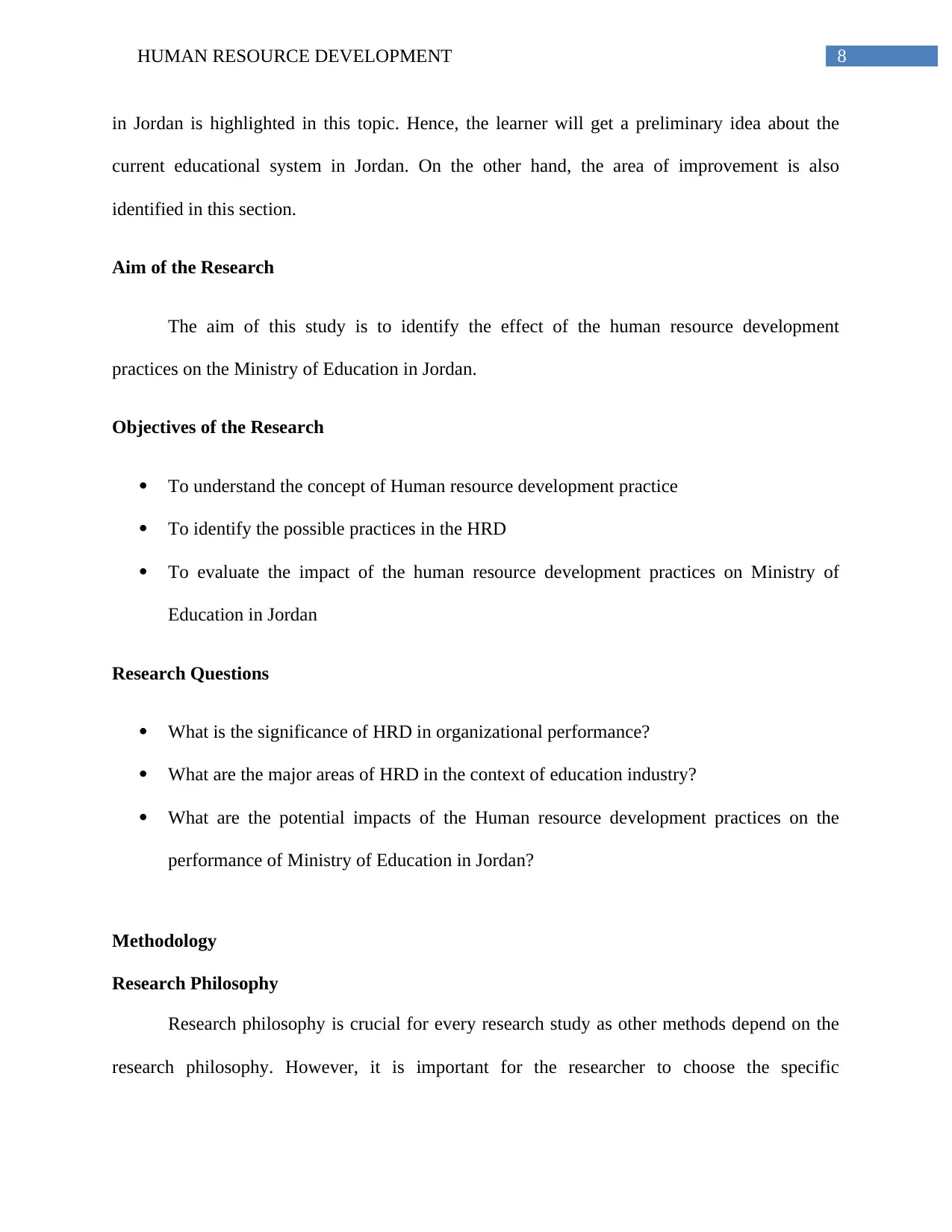
8HUMAN RESOURCE DEVELOPMENT
in Jordan is highlighted in this topic. Hence, the learner will get a preliminary idea about the
current educational system in Jordan. On the other hand, the area of improvement is also
identified in this section.
Aim of the Research
The aim of this study is to identify the effect of the human resource development
practices on the Ministry of Education in Jordan.
Objectives of the Research
To understand the concept of Human resource development practice
To identify the possible practices in the HRD
To evaluate the impact of the human resource development practices on Ministry of
Education in Jordan
Research Questions
What is the significance of HRD in organizational performance?
What are the major areas of HRD in the context of education industry?
What are the potential impacts of the Human resource development practices on the
performance of Ministry of Education in Jordan?
Methodology
Research Philosophy
Research philosophy is crucial for every research study as other methods depend on the
research philosophy. However, it is important for the researcher to choose the specific
in Jordan is highlighted in this topic. Hence, the learner will get a preliminary idea about the
current educational system in Jordan. On the other hand, the area of improvement is also
identified in this section.
Aim of the Research
The aim of this study is to identify the effect of the human resource development
practices on the Ministry of Education in Jordan.
Objectives of the Research
To understand the concept of Human resource development practice
To identify the possible practices in the HRD
To evaluate the impact of the human resource development practices on Ministry of
Education in Jordan
Research Questions
What is the significance of HRD in organizational performance?
What are the major areas of HRD in the context of education industry?
What are the potential impacts of the Human resource development practices on the
performance of Ministry of Education in Jordan?
Methodology
Research Philosophy
Research philosophy is crucial for every research study as other methods depend on the
research philosophy. However, it is important for the researcher to choose the specific
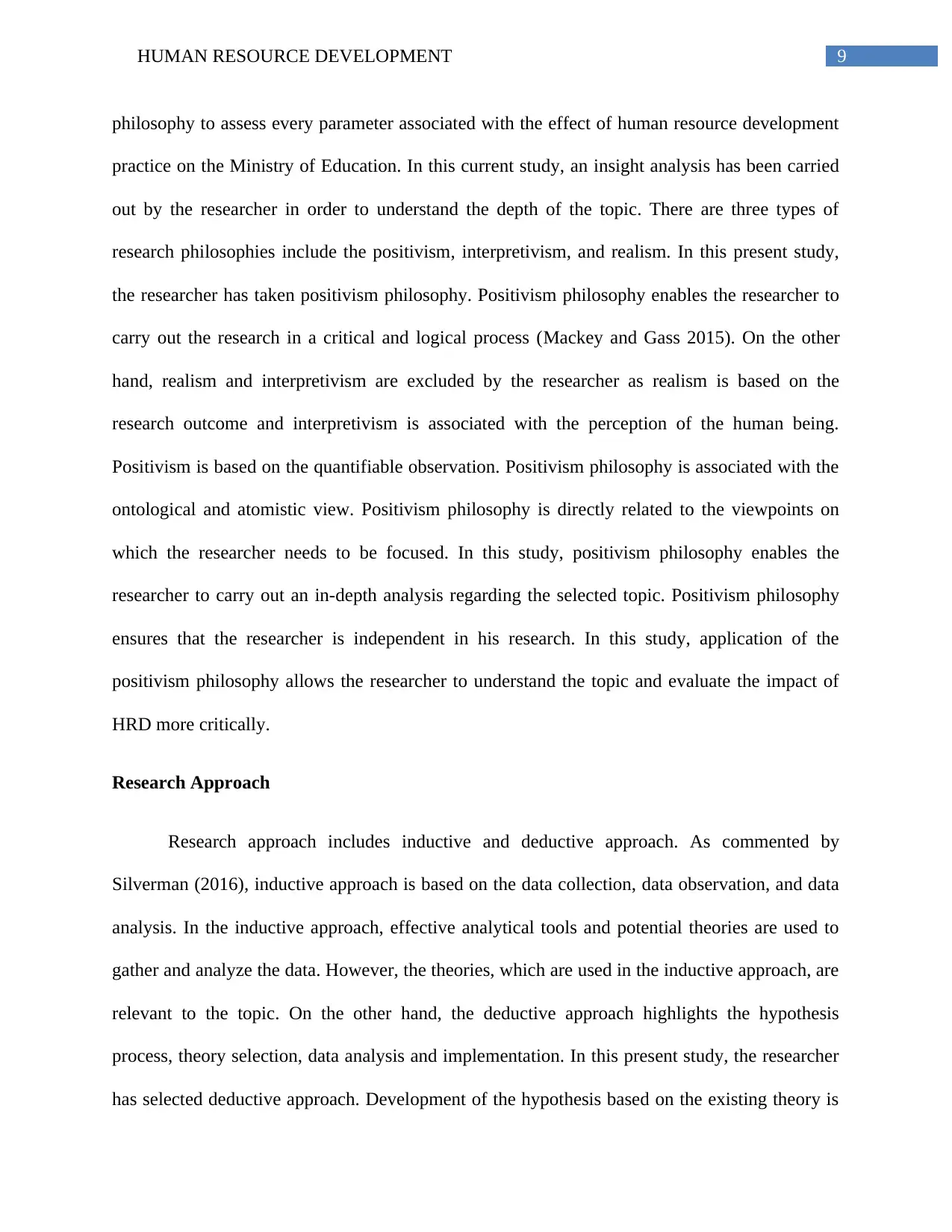
9HUMAN RESOURCE DEVELOPMENT
philosophy to assess every parameter associated with the effect of human resource development
practice on the Ministry of Education. In this current study, an insight analysis has been carried
out by the researcher in order to understand the depth of the topic. There are three types of
research philosophies include the positivism, interpretivism, and realism. In this present study,
the researcher has taken positivism philosophy. Positivism philosophy enables the researcher to
carry out the research in a critical and logical process (Mackey and Gass 2015). On the other
hand, realism and interpretivism are excluded by the researcher as realism is based on the
research outcome and interpretivism is associated with the perception of the human being.
Positivism is based on the quantifiable observation. Positivism philosophy is associated with the
ontological and atomistic view. Positivism philosophy is directly related to the viewpoints on
which the researcher needs to be focused. In this study, positivism philosophy enables the
researcher to carry out an in-depth analysis regarding the selected topic. Positivism philosophy
ensures that the researcher is independent in his research. In this study, application of the
positivism philosophy allows the researcher to understand the topic and evaluate the impact of
HRD more critically.
Research Approach
Research approach includes inductive and deductive approach. As commented by
Silverman (2016), inductive approach is based on the data collection, data observation, and data
analysis. In the inductive approach, effective analytical tools and potential theories are used to
gather and analyze the data. However, the theories, which are used in the inductive approach, are
relevant to the topic. On the other hand, the deductive approach highlights the hypothesis
process, theory selection, data analysis and implementation. In this present study, the researcher
has selected deductive approach. Development of the hypothesis based on the existing theory is
philosophy to assess every parameter associated with the effect of human resource development
practice on the Ministry of Education. In this current study, an insight analysis has been carried
out by the researcher in order to understand the depth of the topic. There are three types of
research philosophies include the positivism, interpretivism, and realism. In this present study,
the researcher has taken positivism philosophy. Positivism philosophy enables the researcher to
carry out the research in a critical and logical process (Mackey and Gass 2015). On the other
hand, realism and interpretivism are excluded by the researcher as realism is based on the
research outcome and interpretivism is associated with the perception of the human being.
Positivism is based on the quantifiable observation. Positivism philosophy is associated with the
ontological and atomistic view. Positivism philosophy is directly related to the viewpoints on
which the researcher needs to be focused. In this study, positivism philosophy enables the
researcher to carry out an in-depth analysis regarding the selected topic. Positivism philosophy
ensures that the researcher is independent in his research. In this study, application of the
positivism philosophy allows the researcher to understand the topic and evaluate the impact of
HRD more critically.
Research Approach
Research approach includes inductive and deductive approach. As commented by
Silverman (2016), inductive approach is based on the data collection, data observation, and data
analysis. In the inductive approach, effective analytical tools and potential theories are used to
gather and analyze the data. However, the theories, which are used in the inductive approach, are
relevant to the topic. On the other hand, the deductive approach highlights the hypothesis
process, theory selection, data analysis and implementation. In this present study, the researcher
has selected deductive approach. Development of the hypothesis based on the existing theory is
⊘ This is a preview!⊘
Do you want full access?
Subscribe today to unlock all pages.

Trusted by 1+ million students worldwide
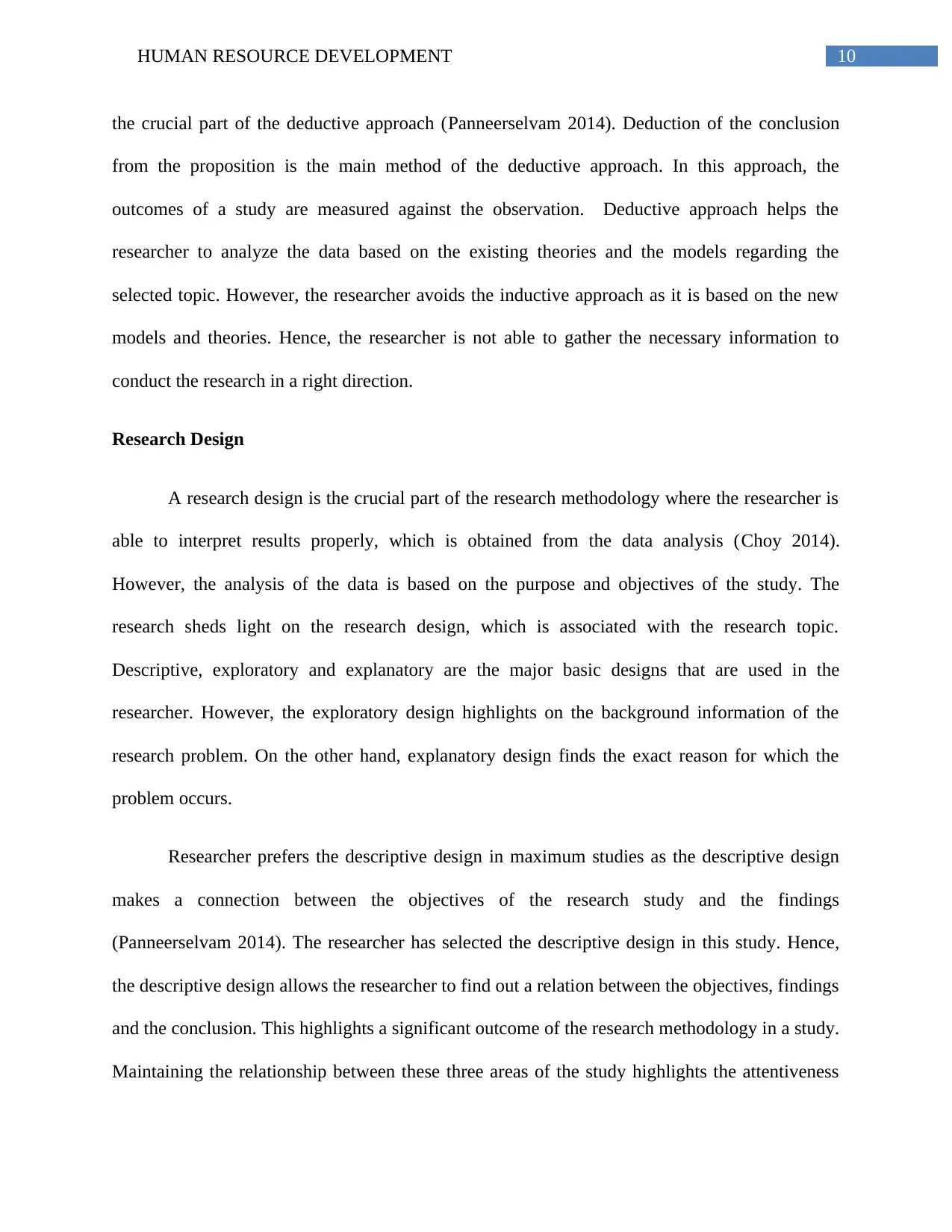
10HUMAN RESOURCE DEVELOPMENT
the crucial part of the deductive approach (Panneerselvam 2014). Deduction of the conclusion
from the proposition is the main method of the deductive approach. In this approach, the
outcomes of a study are measured against the observation. Deductive approach helps the
researcher to analyze the data based on the existing theories and the models regarding the
selected topic. However, the researcher avoids the inductive approach as it is based on the new
models and theories. Hence, the researcher is not able to gather the necessary information to
conduct the research in a right direction.
Research Design
A research design is the crucial part of the research methodology where the researcher is
able to interpret results properly, which is obtained from the data analysis (Choy 2014).
However, the analysis of the data is based on the purpose and objectives of the study. The
research sheds light on the research design, which is associated with the research topic.
Descriptive, exploratory and explanatory are the major basic designs that are used in the
researcher. However, the exploratory design highlights on the background information of the
research problem. On the other hand, explanatory design finds the exact reason for which the
problem occurs.
Researcher prefers the descriptive design in maximum studies as the descriptive design
makes a connection between the objectives of the research study and the findings
(Panneerselvam 2014). The researcher has selected the descriptive design in this study. Hence,
the descriptive design allows the researcher to find out a relation between the objectives, findings
and the conclusion. This highlights a significant outcome of the research methodology in a study.
Maintaining the relationship between these three areas of the study highlights the attentiveness
the crucial part of the deductive approach (Panneerselvam 2014). Deduction of the conclusion
from the proposition is the main method of the deductive approach. In this approach, the
outcomes of a study are measured against the observation. Deductive approach helps the
researcher to analyze the data based on the existing theories and the models regarding the
selected topic. However, the researcher avoids the inductive approach as it is based on the new
models and theories. Hence, the researcher is not able to gather the necessary information to
conduct the research in a right direction.
Research Design
A research design is the crucial part of the research methodology where the researcher is
able to interpret results properly, which is obtained from the data analysis (Choy 2014).
However, the analysis of the data is based on the purpose and objectives of the study. The
research sheds light on the research design, which is associated with the research topic.
Descriptive, exploratory and explanatory are the major basic designs that are used in the
researcher. However, the exploratory design highlights on the background information of the
research problem. On the other hand, explanatory design finds the exact reason for which the
problem occurs.
Researcher prefers the descriptive design in maximum studies as the descriptive design
makes a connection between the objectives of the research study and the findings
(Panneerselvam 2014). The researcher has selected the descriptive design in this study. Hence,
the descriptive design allows the researcher to find out a relation between the objectives, findings
and the conclusion. This highlights a significant outcome of the research methodology in a study.
Maintaining the relationship between these three areas of the study highlights the attentiveness
Paraphrase This Document
Need a fresh take? Get an instant paraphrase of this document with our AI Paraphraser
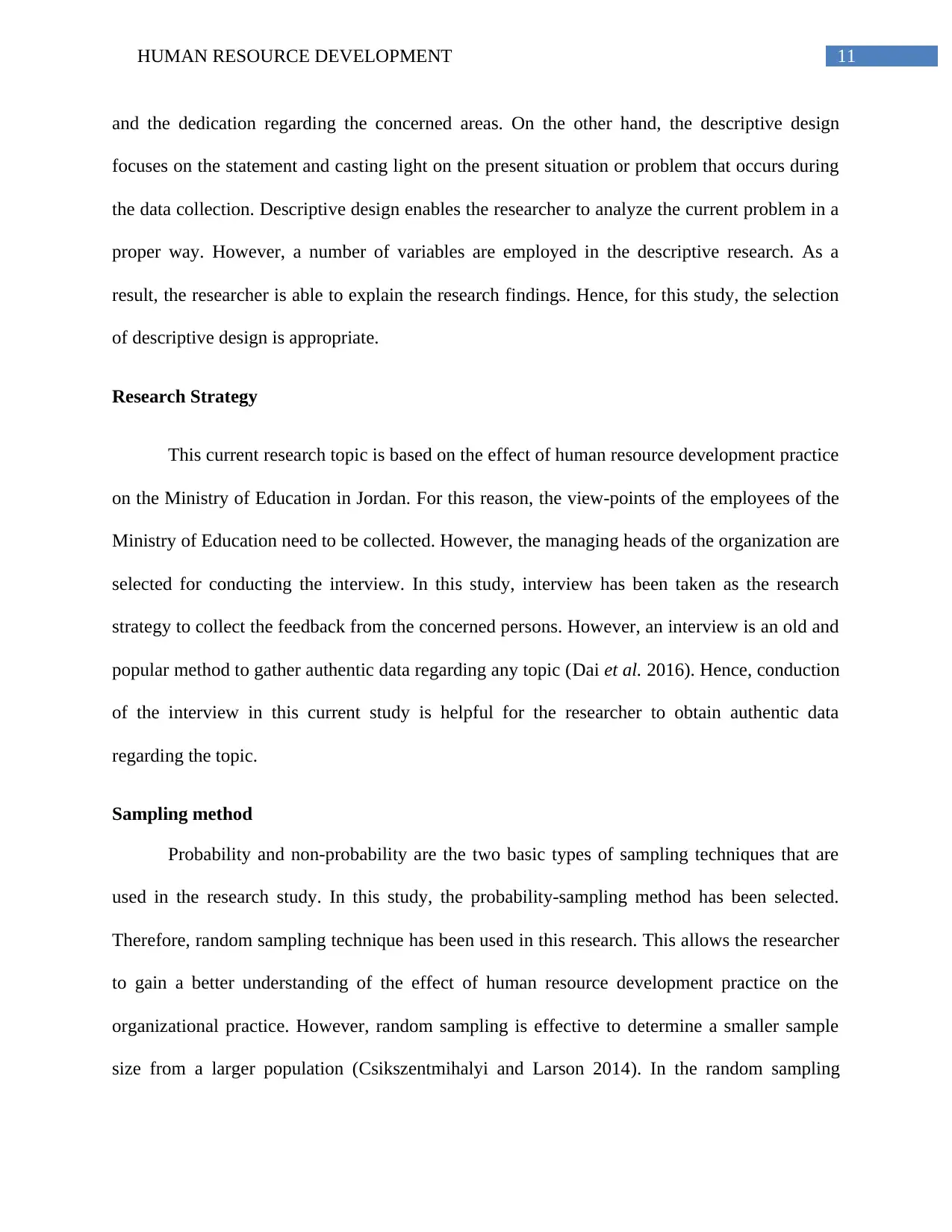
11HUMAN RESOURCE DEVELOPMENT
and the dedication regarding the concerned areas. On the other hand, the descriptive design
focuses on the statement and casting light on the present situation or problem that occurs during
the data collection. Descriptive design enables the researcher to analyze the current problem in a
proper way. However, a number of variables are employed in the descriptive research. As a
result, the researcher is able to explain the research findings. Hence, for this study, the selection
of descriptive design is appropriate.
Research Strategy
This current research topic is based on the effect of human resource development practice
on the Ministry of Education in Jordan. For this reason, the view-points of the employees of the
Ministry of Education need to be collected. However, the managing heads of the organization are
selected for conducting the interview. In this study, interview has been taken as the research
strategy to collect the feedback from the concerned persons. However, an interview is an old and
popular method to gather authentic data regarding any topic (Dai et al. 2016). Hence, conduction
of the interview in this current study is helpful for the researcher to obtain authentic data
regarding the topic.
Sampling method
Probability and non-probability are the two basic types of sampling techniques that are
used in the research study. In this study, the probability-sampling method has been selected.
Therefore, random sampling technique has been used in this research. This allows the researcher
to gain a better understanding of the effect of human resource development practice on the
organizational practice. However, random sampling is effective to determine a smaller sample
size from a larger population (Csikszentmihalyi and Larson 2014). In the random sampling
and the dedication regarding the concerned areas. On the other hand, the descriptive design
focuses on the statement and casting light on the present situation or problem that occurs during
the data collection. Descriptive design enables the researcher to analyze the current problem in a
proper way. However, a number of variables are employed in the descriptive research. As a
result, the researcher is able to explain the research findings. Hence, for this study, the selection
of descriptive design is appropriate.
Research Strategy
This current research topic is based on the effect of human resource development practice
on the Ministry of Education in Jordan. For this reason, the view-points of the employees of the
Ministry of Education need to be collected. However, the managing heads of the organization are
selected for conducting the interview. In this study, interview has been taken as the research
strategy to collect the feedback from the concerned persons. However, an interview is an old and
popular method to gather authentic data regarding any topic (Dai et al. 2016). Hence, conduction
of the interview in this current study is helpful for the researcher to obtain authentic data
regarding the topic.
Sampling method
Probability and non-probability are the two basic types of sampling techniques that are
used in the research study. In this study, the probability-sampling method has been selected.
Therefore, random sampling technique has been used in this research. This allows the researcher
to gain a better understanding of the effect of human resource development practice on the
organizational practice. However, random sampling is effective to determine a smaller sample
size from a larger population (Csikszentmihalyi and Larson 2014). In the random sampling
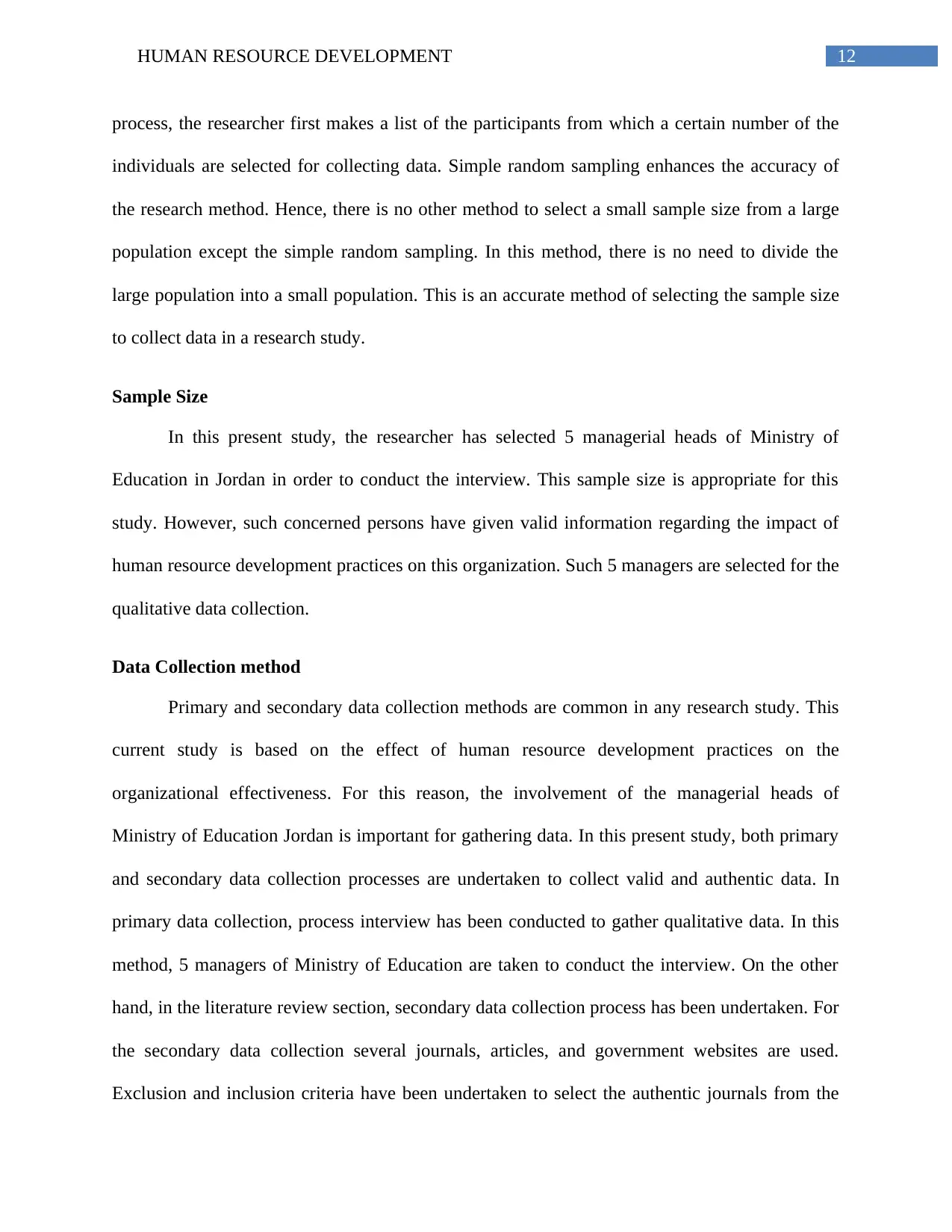
12HUMAN RESOURCE DEVELOPMENT
process, the researcher first makes a list of the participants from which a certain number of the
individuals are selected for collecting data. Simple random sampling enhances the accuracy of
the research method. Hence, there is no other method to select a small sample size from a large
population except the simple random sampling. In this method, there is no need to divide the
large population into a small population. This is an accurate method of selecting the sample size
to collect data in a research study.
Sample Size
In this present study, the researcher has selected 5 managerial heads of Ministry of
Education in Jordan in order to conduct the interview. This sample size is appropriate for this
study. However, such concerned persons have given valid information regarding the impact of
human resource development practices on this organization. Such 5 managers are selected for the
qualitative data collection.
Data Collection method
Primary and secondary data collection methods are common in any research study. This
current study is based on the effect of human resource development practices on the
organizational effectiveness. For this reason, the involvement of the managerial heads of
Ministry of Education Jordan is important for gathering data. In this present study, both primary
and secondary data collection processes are undertaken to collect valid and authentic data. In
primary data collection, process interview has been conducted to gather qualitative data. In this
method, 5 managers of Ministry of Education are taken to conduct the interview. On the other
hand, in the literature review section, secondary data collection process has been undertaken. For
the secondary data collection several journals, articles, and government websites are used.
Exclusion and inclusion criteria have been undertaken to select the authentic journals from the
process, the researcher first makes a list of the participants from which a certain number of the
individuals are selected for collecting data. Simple random sampling enhances the accuracy of
the research method. Hence, there is no other method to select a small sample size from a large
population except the simple random sampling. In this method, there is no need to divide the
large population into a small population. This is an accurate method of selecting the sample size
to collect data in a research study.
Sample Size
In this present study, the researcher has selected 5 managerial heads of Ministry of
Education in Jordan in order to conduct the interview. This sample size is appropriate for this
study. However, such concerned persons have given valid information regarding the impact of
human resource development practices on this organization. Such 5 managers are selected for the
qualitative data collection.
Data Collection method
Primary and secondary data collection methods are common in any research study. This
current study is based on the effect of human resource development practices on the
organizational effectiveness. For this reason, the involvement of the managerial heads of
Ministry of Education Jordan is important for gathering data. In this present study, both primary
and secondary data collection processes are undertaken to collect valid and authentic data. In
primary data collection, process interview has been conducted to gather qualitative data. In this
method, 5 managers of Ministry of Education are taken to conduct the interview. On the other
hand, in the literature review section, secondary data collection process has been undertaken. For
the secondary data collection several journals, articles, and government websites are used.
Exclusion and inclusion criteria have been undertaken to select the authentic journals from the
⊘ This is a preview!⊘
Do you want full access?
Subscribe today to unlock all pages.

Trusted by 1+ million students worldwide
1 out of 38
Related Documents
Your All-in-One AI-Powered Toolkit for Academic Success.
+13062052269
info@desklib.com
Available 24*7 on WhatsApp / Email
![[object Object]](/_next/static/media/star-bottom.7253800d.svg)
Unlock your academic potential
Copyright © 2020–2025 A2Z Services. All Rights Reserved. Developed and managed by ZUCOL.




